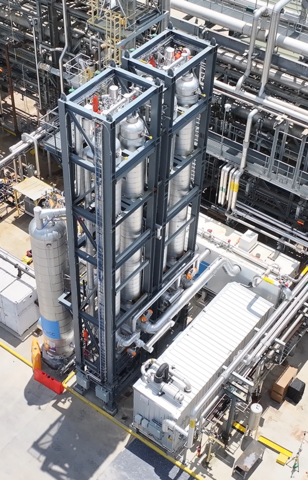Carbon America’s FrostCC™ Technology Demonstrates Ultraclean Carbon Capture
Published by Todd Bush on August 7, 2024
The cryogenic carbon capture technology achieved 1,000 hours of carbon capture while proving the ability to remove co-pollutants from flue gas.
ARVADA, Colo.--(BUSINESS WIRE)--Carbon America’s novel cryogenic carbon capture technology, FrostCC™, has successfully completed 1,000 hours of testing at the National Carbon Capture Center (NCCC), a neutral research facility for third-party carbon capture developers, located in Wilsonville, Alabama.
FrostCC™ is a cryogenic point-source carbon capture system which removes carbon dioxide (CO2) from flue gas before it is released into the atmosphere. It does this by cooling the flue gas below the sublimation temperature of CO2, causing it to "frost" as dry ice and physically separate from the gas mixture. This solid CO2 is periodically melted and collected as a liquid, making it ready for compression and transportation to storage sites. FrostCC*™* does all of this without the use of water or chemicals and runs exclusively on electricity.

The FrostCC™ system installed at the National Carbon Capture Center in Wilsonville, Alabama.
>> In Other News: Raven SR's Spanish Waste-To-Hydrogen Facility Declared "A Project and Investment of Regional Interest"
During its testing at NCCC, FrostCC™ successfully demonstrated its ability to capture carbon dioxide and co-pollutants from flue gas and further validated the process and models for design. The next step in development for FrostCC™ will be a demonstration of its full-scale commercial product. “The prospects of this breakthrough technology inspired Carbon America’s founding and we’re excited to see it realized. It has been inspiring to watch it go from a concept to an engineering-scale pilot that has achieved material results,” said Brent Lewis, Chief Executive Officer and Co-Founder of Carbon America.
The team also ran systematic tests to explore the operational boundaries of FrostCC™. These tests were designed to further the understanding and characterization of the system's performance in a relevant environment and under realistic conditions, achieving a technology readiness level (TRL) of 6.
“Experimental data from the testing at NCCC not just proved FrostCC’s™ viability as an effective carbon capture technology, but also validated the physics-based models that enable design of the commercial product. Looking to the future we have confidence in our path to a commercial product,” said Miles Abarr, Chief Technology Officer of Carbon America.
“Key differentiators for our innovative technology include its proven ability to remove co-pollutants without separate treatment, and no concerns about other environmental emissions. Coupled with plug-and-play retrofit ability and economies of scale driven by mass manufacturing and existing supply chains, FrostCC™ presents an unparalleled opportunity to do maximum clean up with one simple solution,” reflected Ashleigh Ross, Head of Commercial Development and Policy at Carbon America.
Following the NCCC pilot, Carbon America plans to deploy the first iteration of the standard commercial FrostCC™ module. This module will be ready for broad commercial application across various emission-intensive industries such as power plants, cement and steel, pulp and paper, and other production facilities.
About Carbon America
Carbon America is a Colorado-based vertically integrated carbon capture and storage (CCS) developer, owner, and operator with a mission to quickly and safely capture and store as much carbon dioxide as possible. The company’s team of world-class experts cover the entire CCS value chain, including capture processes; geology, geoscience, reservoir engineering; project development; commercial, finance, and tax equity structuring; regulatory and advocacy engagement; and acquisition of necessary land and sequestration site management for CO₂ storage. The company is currently developing CCS projects at three ethanol plants that combined could reduce CO2 emissions by ~525,000 metric tons annually. In addition, the company has been selected, alongside Colorado School of Mines and Los Alamos National Laboratory, for CarbonSAFE Phase III funding for Project Eos near Pueblo, Colorado, in addition to DAC hub feasibility studies in Colorado and Florida with partners University of Illinois. Carbon America is also developing a proprietary cryogenic technology, FrostCC™, which stands to improve the cost, performance, and environmental footprint of carbon capture.
Subscribe to the newsletter
Daily decarbonization data and news delivered to your inbox
Follow the money flow of climate, technology, and energy investments to uncover new opportunities and jobs.
Latest issues
-
The Three-Continent Move That Redefines SAF
Wishing everyone a restful holiday season.🎄🎅🎁 Inside this Issue ✈️ Cathay Goes Global With SAF in Three-Continent Fuel Deal 🧪 Proton Ventures Partners With Barents Blue For Realization Of The Bar...
-
Can One Truck Fix Hydrogen’s Biggest Problem?
Inside This Issue 🚛 Alberta's Shared Truck Model Could Crack Hydrogen Adoption ✈️ ZeroAvia Completes Financing Round 🌾 Frontier And NULIFE Scale New Biowaste Carbon Removal Approach 🔥 WAGABOX® Of ...
-
North America’s Carbon Removal Year in Review: Winners, Losers, Surprises
Inside This Issue 🌎 North America's Carbon Removal Year in Review: The Deals, Policies, and Milestones That Shaped 2025 🚢 Hapag-Lloyd And North Sea Container Line Win ZEMBA Second E-Fuel Tender 🪨 ...
Company Announcements
-
Vallourec, a world leader in premium seamless tubular solutions, and Geostock, a global specialist in underground storage of energy, have signed a Memorandum of Understanding (MoU) to strengthen th...
-
CMA CGM, DHL Step Up Ocean Freight Decarbonization with Biofuel Deal
DHL Global Forwarding and shipping group CMA CGM have agreed to jointly use 8,990 metric tons of second-generation biofuel to reduce emissions from ocean freight. The initiative is expected to cut...
-
Next-Generation Gas Turbine Control System For Thermal Power Plants Completes Functional Testing
Integration of Mitsubishi Power's control technology with Mitsubishi Electric's high-speed data processing technology Supports rapid load adjustments and diverse fuels including hydrogen Tokyo, ...
-
Proton Ventures Partners With Barents Blue For Realization Of The Barents Clean Ammonia Project
Barents Blue AS today announces Proton Ventures as new partner to the Barents Clean Ammonia Project (formerly known as the Barents Blue project). The Dutch engineering and project development compa...